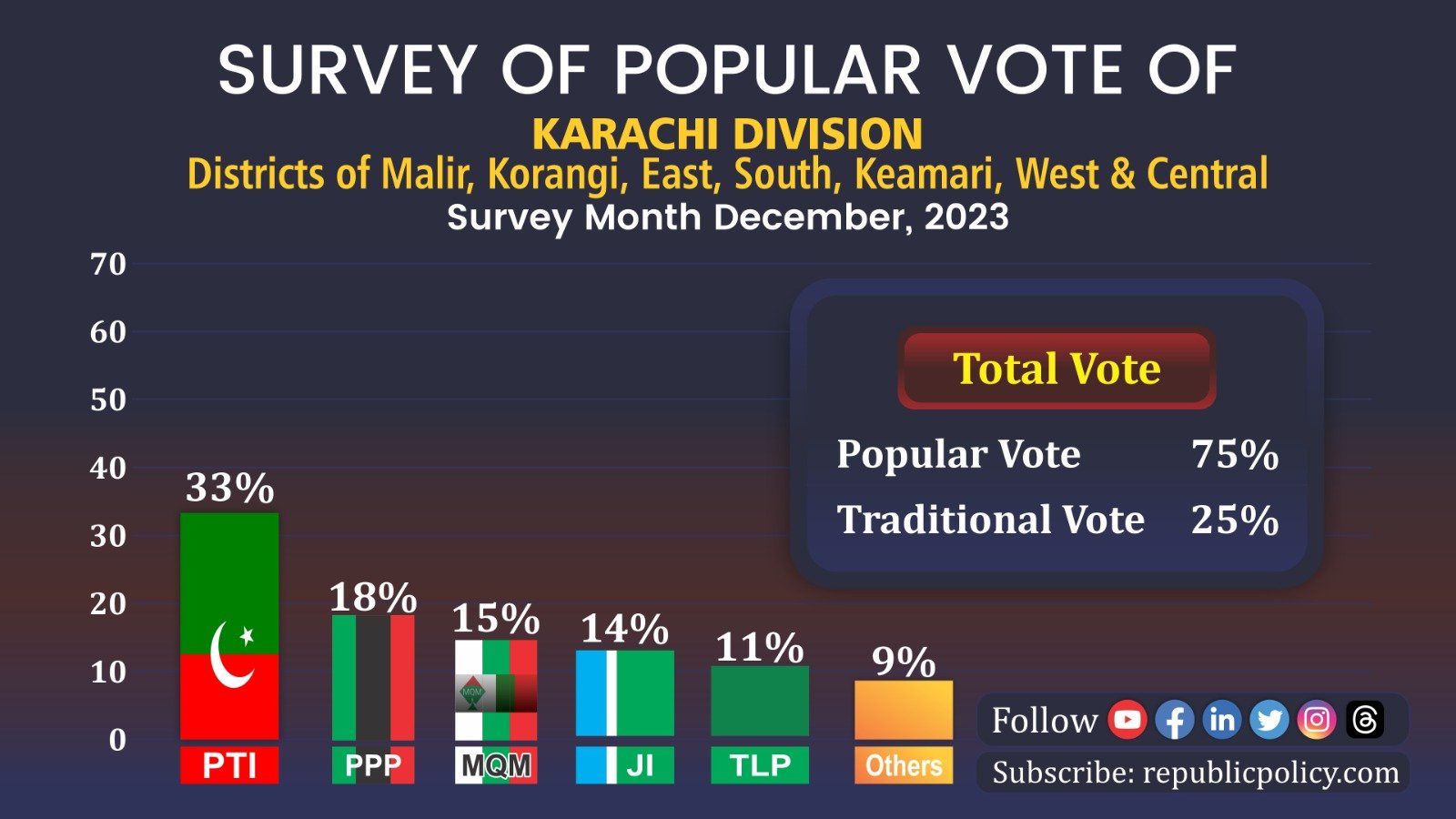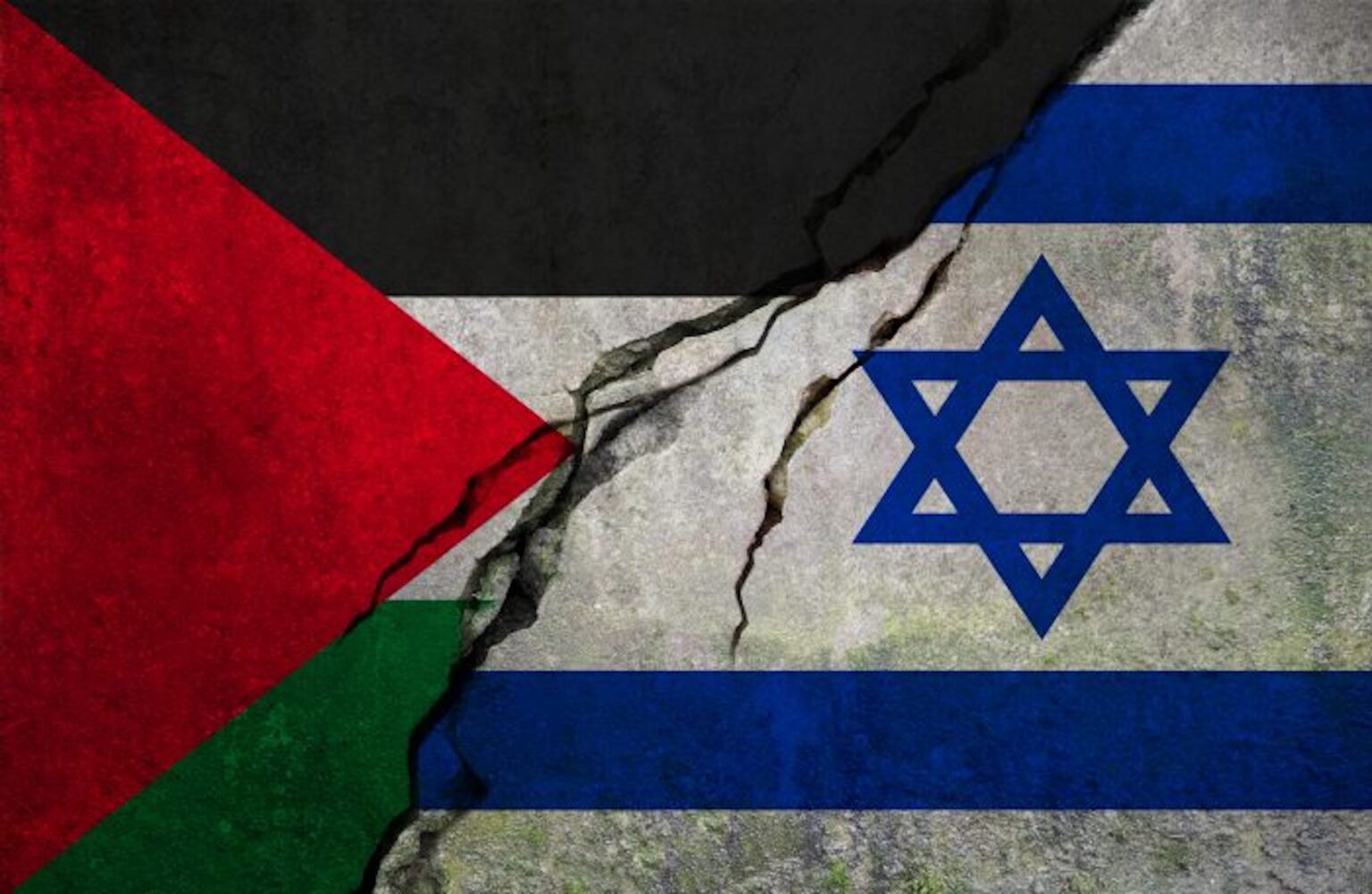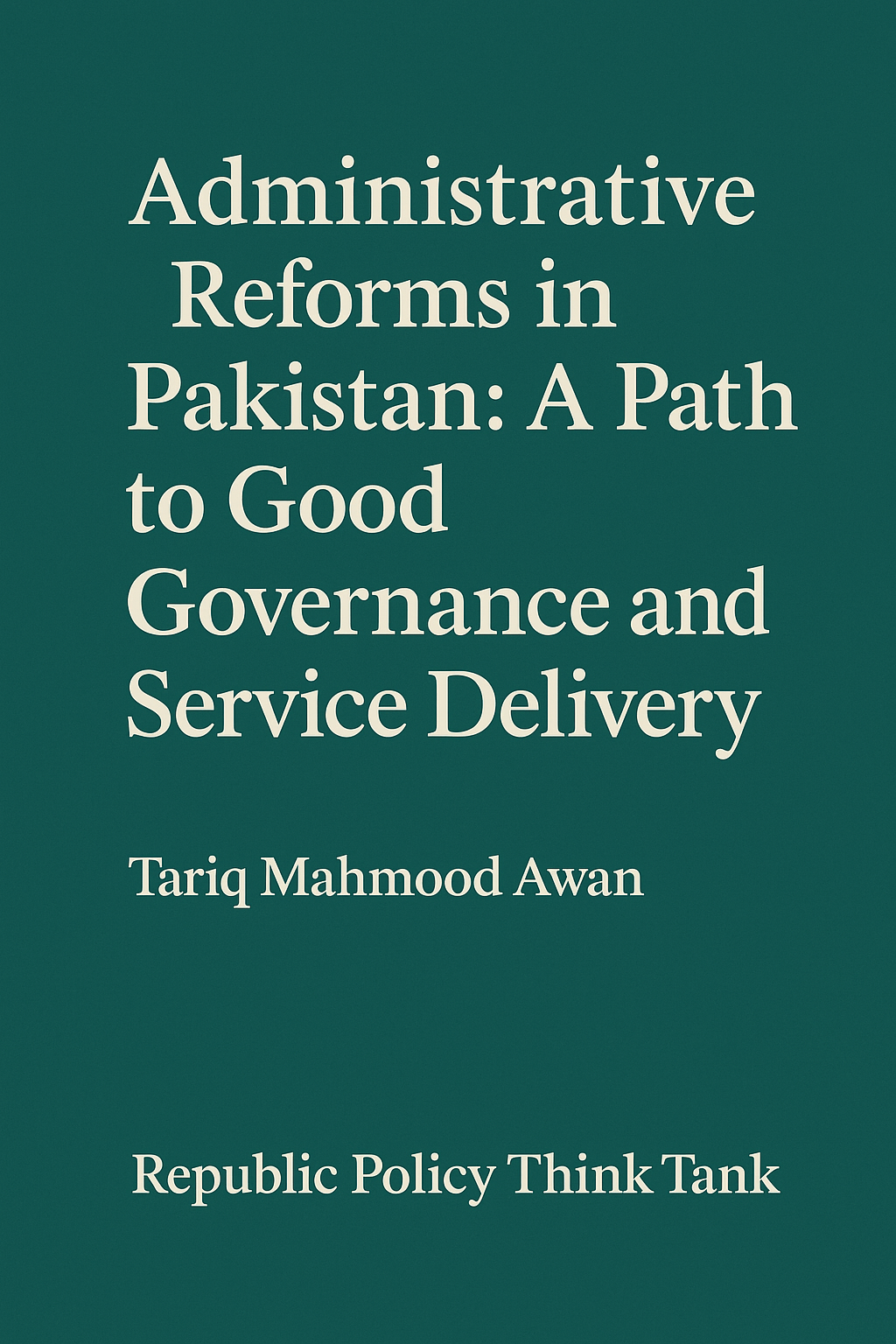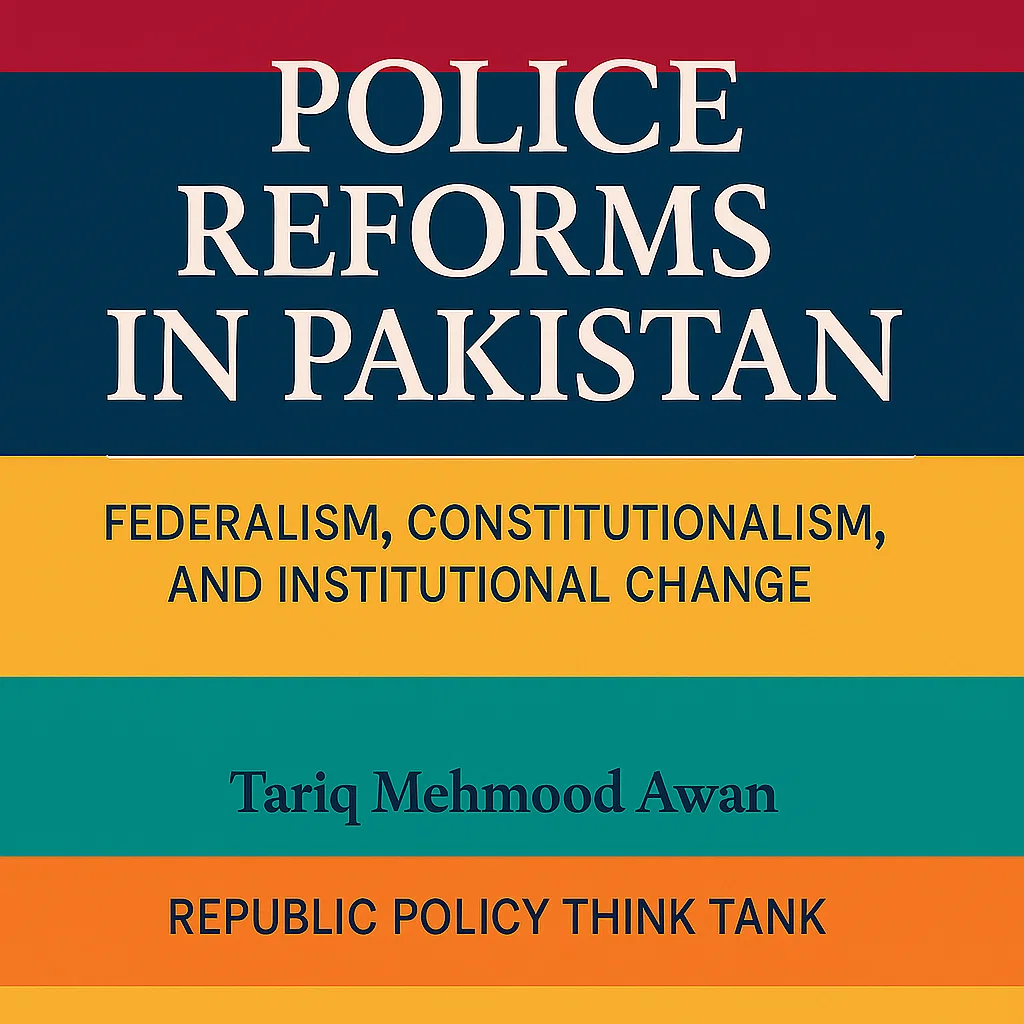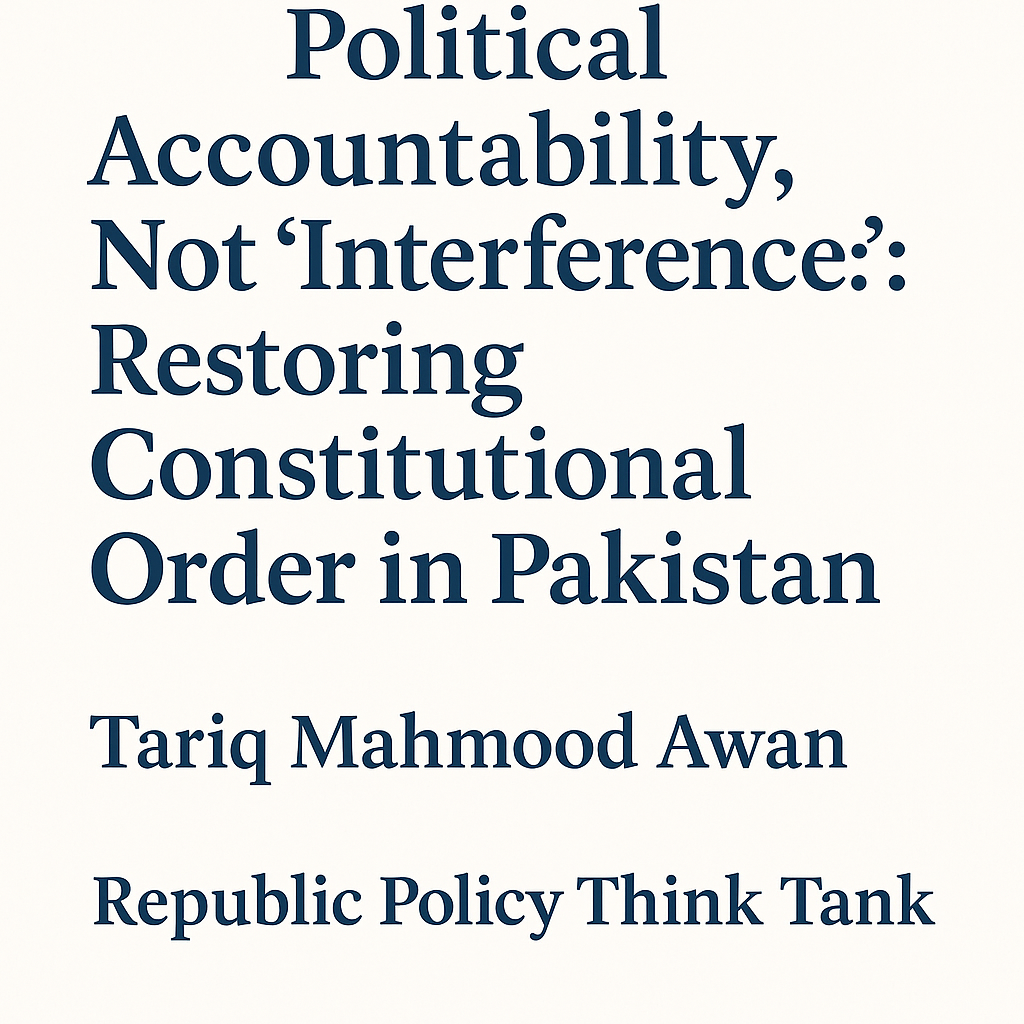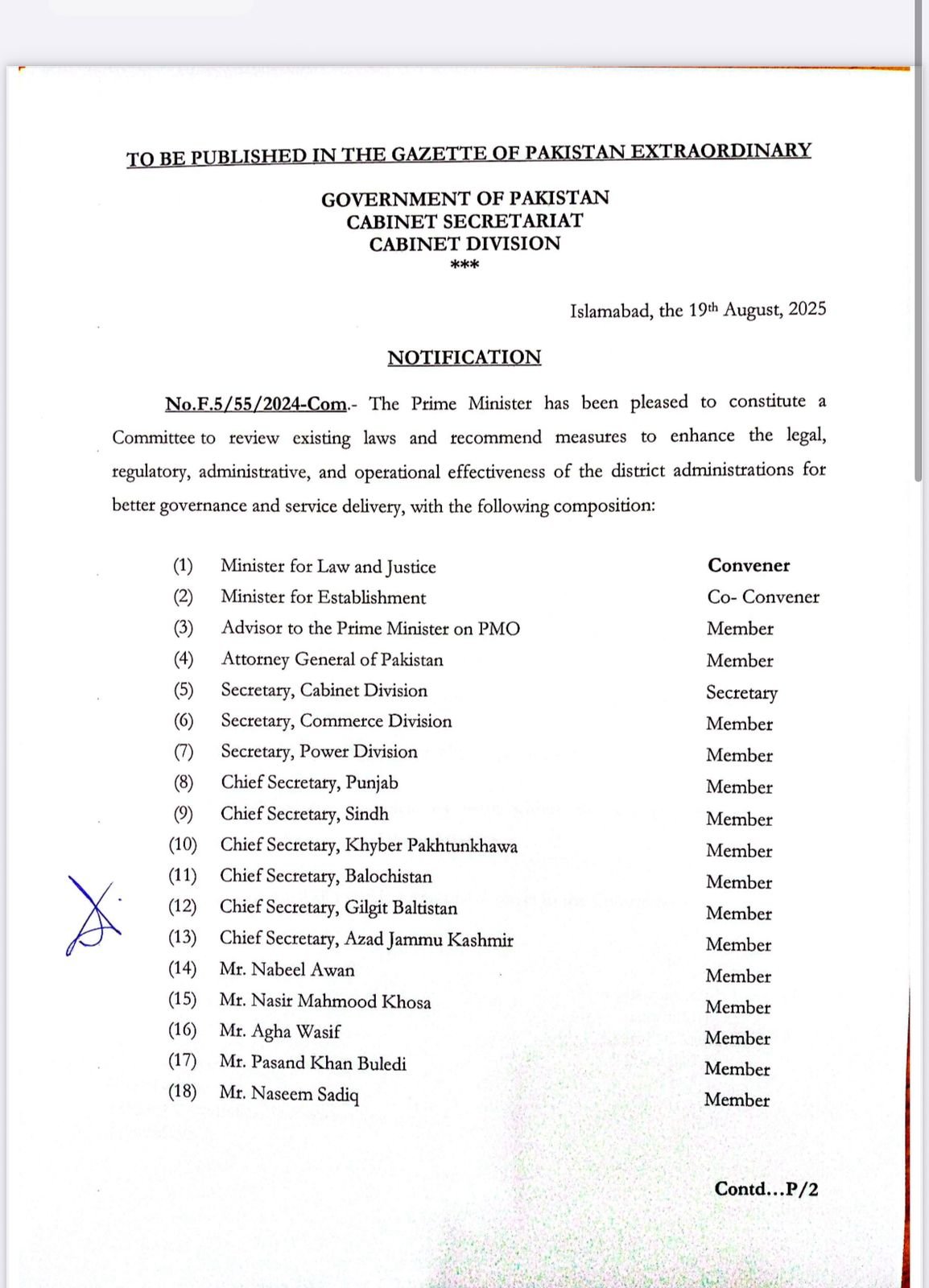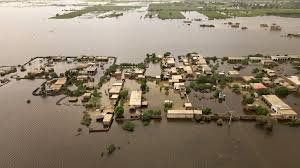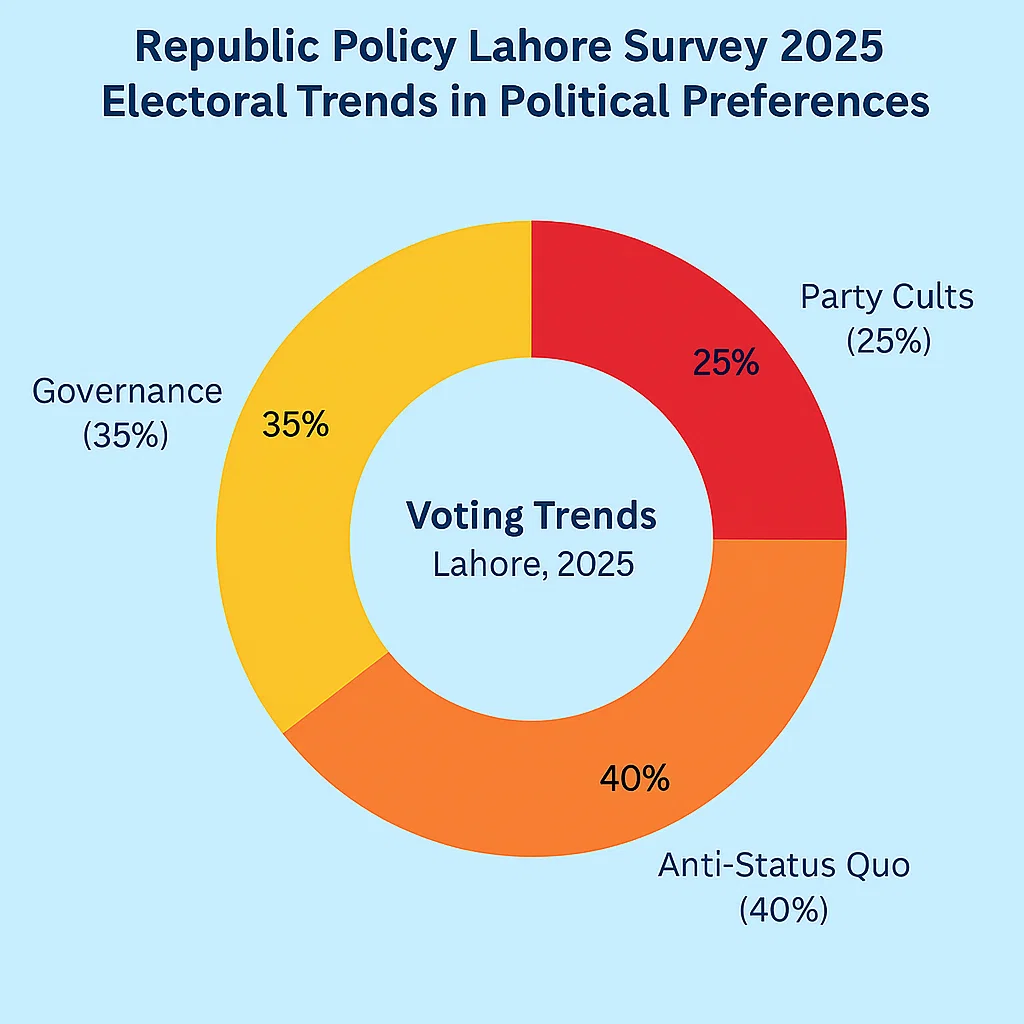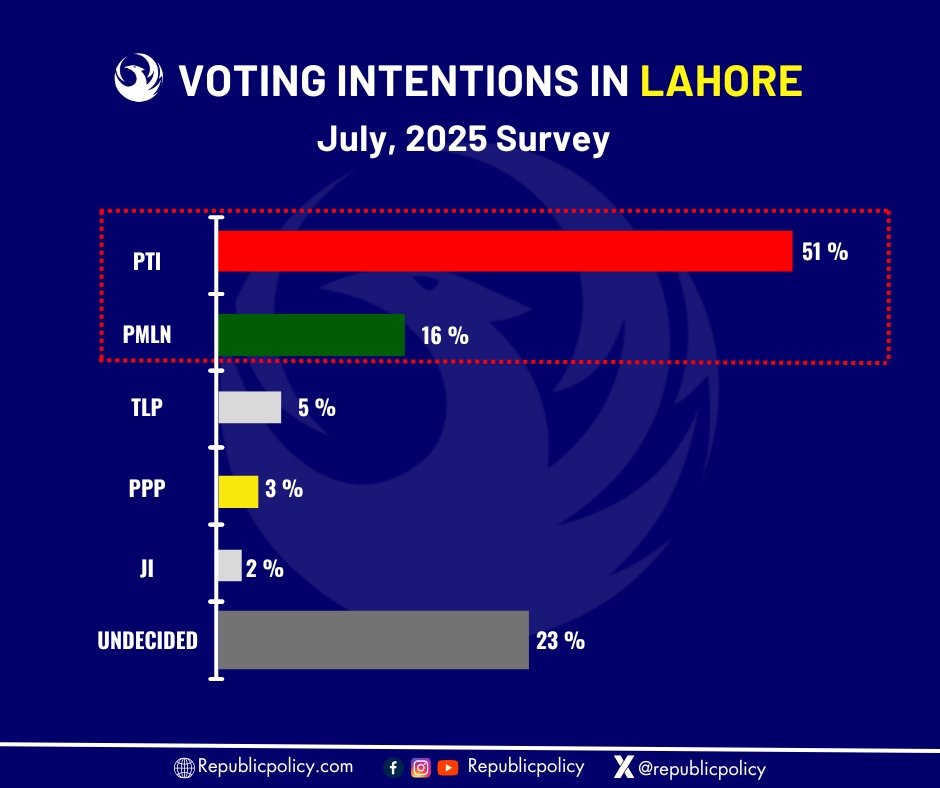Team Republic Policy
Pakistan is a Federal Republic according to Article 1 of the Constitution of Pakistan. Therefore, the government will be formed by the people’s chosen representatives. Then, Pakistan has a parliamentary form of governance. The parliament of Pakistan is bicameral. It consists of the National Assembly, Senate and the president of Pakistan. Article 52 of the Constitution of Pakistan provides five years as the term of the national assembly. According to Article 224, the Election Commission of Pakistan is responsible for conducting free and transparent elections. The Election Commission of Pakistan has announced the general election date for both national and provincial assemblies on February 8, 2024.
As elections are around the corner, therefore, it is essential to measure the political trends. Therefore, as an organization, Republic Policy often conducts different types of polls, surveys and voting to know and measure political trends. Accordingly, Republic Policy has conducted a constituency-based survey of National Assembly seats in the Karachi division. It is critical to know that it is a constituency politics in Pakistan. Therefore, the primary survey can only determine who wins how many constituencies. The other derivative measurements are presidential, like a popular leader or party, which might not be central to constituency politics.
A constituency-based election survey is a type of survey that collects data on the opinions and preferences of voters in a specific electoral district or constituency. Such surveys are conducted to understand the political behaviour and attitudes of the electorate, as well as to predict the outcome of an election based on various factors.
Election-based surveys are conducted for various reasons, such as to measure the level of support and satisfaction for different political parties, candidates, and policies among the voters and to identify the key issues and concerns that influence the voting decisions of the voters.
Furthermore, they are conducted to assess the impact of demographic, social, and economic factors on the voters’ voting behaviour alongside evaluating the effectiveness of campaign strategies and communication methods used by the political actors. Then, providing feedback and guidance for the political actors to improve their performance and appeal to the voters is also critical. Surveys are meant to collect data so that policy derivatives may be developed. A survey is always dependent upon the questionnaire and the methodology of the survey. A survey can only be evaluated through its methodology.
Election-based surveys can be conducted using different methods, such as:
Face-to-face interviews: This method involves interviewing a representative sample of voters in person, using a structured or semi-structured questionnaire. This method can provide rich and detailed data, but it can also be costly and time-consuming.
Telephone interviews: This method involves calling a random or selected sample of voters and asking them questions over the phone. This method can be faster and cheaper than face-to-face interviews, but it can also suffer from low response rates and potential biases.
Online surveys: This method involves sending an electronic questionnaire to a panel or a list of voters who have agreed to participate in online surveys. This method can be convenient and flexible, but it can also have issues with sampling quality and validity.
Mail surveys: This method involves mailing a paper questionnaire to a sample of voters and asking them to return it by post. This method can be simple and inexpensive, but it can also have low response rates and delays in data collection.
Election-based surveys can provide valuable insights into the political landscape and dynamics of a constituency, as well as help the political actors tailor their messages and actions to the needs and preferences of the voters. However, election-based surveys also have some limitations, such as:
Sampling errors: This refers to the possibility that the sample of voters surveyed may not accurately represent the population of voters in the constituency. This can affect the reliability and generalizability of the survey results.
Measurement errors: This refers to the possibility that the questions asked in the survey may not capture the true opinions and preferences of the voters. This can affect the validity and accuracy of the survey results.
Response errors: This refers to the possibility that the respondents may not answer the survey questions honestly or consistently. This can affect the quality and credibility of the survey results.
Therefore, election-based surveys should be designed and conducted carefully, using appropriate methods and techniques, to ensure that they produce reliable and valid data that can inform and improve the political process. Accordingly, Republic Policy has conducted a constituency-based survey of all the districts of the Karachi division. Earlier, Republic Policy introduced constituency-based surveys in Pakistan. Therefore, primary data has been collected constituency-wise. Furthermore, constituencies are divided among union councils. Karachi has 246 union councils. The basic unit of the survey is the union council. Then, there is at least a sample size of 25 voters per UC with five feedbacks. Hence, the sample size is 6150. The duration of the survey is from December 10, 2023, to December 25, 2023. The union councils are the political measurement of the Local government department of Sindh, whereas the Election Commission of Pakistan divides the constituencies into populations. The delimitation of 2023 is used for collecting data for the Karachi survey.
Methodology of the Survey:
It is very significant to understand the methodology of the survey. The first part is that it is a constituency-based survey. The constituencies from NA-229 to NA-250 are distributed for data collection, with the Union Council as the basic unit.
The questionnaire is one:
Which political party will you vote for if elections are held today?
The data in line with the questionnaire is further taken from two sources.
- Data is collected from the common voters, at least 25 from each UC comprising an NA constituency representing age, gender, professions and communities.
- Data is collected from different representative communities in the NA constituency.
Thus, data is compiled accordingly. Then, the primary data is measured with five feedbacks to measure the political trend of the constituencies.
The five pieces of feedback are the following:
- Who is the most popular political leader?
- Which is the most popular political party?
- Who is the most favourite candidate of the constituency?
- What is the first preference to vote?
- Who is the second-most favourite leader, party or candidate to vote?
Karachi Survey:
Karachi is the largest and most diverse city in Pakistan, with a population of over 20 million people belonging to various ethnic, linguistic, religious, and political groups. The city has 22 national and 47 provincial assembly seats, which are distributed among seven districts: Malir, Korangi, East, South, Keamari, West, and Central. The city also has 246 union councils, which are the lowest tier of local government. Several factors, such as the historical legacy of migration, the economic and social development, the security and law and order situation, the role of the federal and provincial governments, and the political mobilization and representation of different groups, languages and ethnicities, influence the city’s politics.
The city has witnessed several changes in its political landscape in the past decade, especially since the 2013 general elections, when a new political party, the Pakistan Tehreek-e-Insaf (PTI), emerged as a major contender for power in the city. The PTI, led by former cricketer Imran Khan, challenged the dominance of the Muttahida Qaumi Movement (MQM), which had been the main representative of the Urdu-speaking community, also known as Muhajirs, who migrated from India after the partition of 1947. The PTI also competed with the Pakistan Peoples Party (PPP), which had been the ruling party in the province of Sindh since 2008 and had a strong base among the Sindhi-speaking and Baloch communities. The PTI appealed to the urban middle class, the youth, and the ethnic minorities, such as the Pashtuns, Punjabis, and others, who felt marginalized by the MQM and the PPP. The PTI also promised to bring change, accountability, and development to the city, which had been suffering from poor governance, corruption, violence, and neglect.
The PTI’s performance in the 2013 and 2018 general elections was impressive, as it won the majority of the national and provincial assembly seats in Karachi, while the MQM and the PPP lost ground in the general elections of 2018.
The PTI’s success was attributed to its anti-corruption campaign, its charismatic leadership, its alliance with other parties, such as the Grand Democratic Alliance (GDA) and the Balochistan Awami Party (BAP), and its ability to attract voters from different ethnic and religious backgrounds. The PTI also benefited from the decline of the MQM, which had split into several factions after its founder and leader, Altaf Hussain, was banned from addressing the public and accused of treason by the state. The MQM also faced a crackdown by the security forces, who arrested many of its leaders and workers on charges of terrorism, extortion, and murder. The MQM’s loss of power and influence created a political vacuum in the city, which the PTI tried to fill.
However, the PTI’s performance in the 2023 local government elections was disappointing, as it won only 42 out of 246 union council seats, while the PPP won 104 and the Jamaat-e-Islami (JI) won 89. The PPP’s victory was surprising, as it had been widely criticized for its poor governance and corruption in the province. The PPP’s success was attributed to its effective mobilization of its loyal voters, its patronage and distribution of resources, its alliance with other parties, such as the Pakistan Muslim League-Nawaz (PML-N) and the Tehreek-e-Labbaik Pakistan (TLP), and its manipulation of the electoral system, which favoured the rural areas over the urban areas. One of the factors was also the boycott of the elections by the MQM, which otherwise always championed the Local government elections. The JI’s victory was also unexpected, as it had been a marginal player in the city’s politics. The JI’s success was attributed to its grassroots organization, its social welfare activities, its religious appeal, and its support from the Pashtun and Urdu-speaking community, which the PTI’s policies and performance had alienated. The JI also capitalized on the anti-government sentiment and the economic hardship faced by the people due to the COVID-19 pandemic and inflation. The role of Hafiz Naeem was also strong, as so many voters voted for him despite belonging to PTI.
The results of the local government elections revealed the complex and dynamic nature of Karachi’s politics, which are influenced by multiple factors, such as the ethnic, linguistic, religious, and class identities of the voters, the performance and policies of the political parties, the role and interference of the state institutions, and the changing socio-economic conditions of the city. The results also showed that the PTI’s popularity in Karachi was not as stable or strong as it had seemed and that the party faced several challenges and competitors in the city. The results also indicated that the PPP and the JI were not to be underestimated and that they had the potential to challenge the PTI in the next general elections, which are expected to be held in 2024. The results also suggested that the MQM was not completely irrelevant and that it still had a loyal base among the Urdu-speaking community, which could be revived or reactivated in the future.
Introduction of Karachi Survey:
Karachi now has 22 and 47 national and provincial assembly seats, respectively.
NA seat increased in District South, while Malir, East and Central got one more PA seat each. District Malir has three NA seats, NA-229, 230 and 231. District Korangi has three NA seats, NA-232, 233 and 234. District Karachi East has four National Assembly Seats, NA-235, 236, 237 and 238. District Karachi South now has three NA seats, NA-239, 240 and NA 241. District Keamari has two NA seats, NA-242 & NA 243. District Karachi West has three seats, NA- 244, 245 and 246. District Karachi Central has four National Assembly seats: NA-247, 248, 249 and 250. In the general elections of 2018, PTI won 14 out of 21 National assembly seats.
The break up of the Union Council of Karachi and the results of local government elections of 2023.
District Karachi has 246 union councils, and their break up is as follows. Malir has 30 UCs, Korangi 37, East 43, South 26, Keamari 32, West 33, and District Central has 45 UC seats. In the 2023 local government elections, PPP won 104 UC seats, whereas JI won 89 and PTI won 42 seats.
From both general election results of 2018 and local government elections of 2023. Karachites vote on different patterns depending upon political wave, the performance of political parties and the manifestoes of political parties.
The voting patterns according to the UC-wise surveys of Republic Policy are interesting. The survey reveals that the voting patterns in Karachi are primarily linguistic and ethnic-based. However, in general elections since 2013, there has been a political wave that transcends linguistic and ethnic drives.
The district trends of the division of Karachi are as follows. In Malir, Sindhies, Baloch, Pathans and Punjabi live. Sindhies and Baluch commonly vote for PPP, whereas other communities vote for PTI as well. There is a competition between PPP and PTI in Malir, with PPP being the favourite to win. However, there is always a political wave in Karachi, and that could benefit PTI in the Malir district if elections are held freely and fairly. Apart from the popular vote, there is a strong traditional vote bank in the district of Malir.
Furthermore, PPP is also in the lead in the two NA seats of Keamari district, followed by PTI. Sindhies, Pathans, Punjabis, Baluch and locals live here. Then, PTI and PMLN are also present here. Furthermore, this area is also influenced by the political wave of Karachi but in lesser proportions than other parts of Karachi. Popular as well as traditional votes are present here.
PPP is also present in the East and South districts of Karachi. However, they are not the only party here. MQM, PTI, and JI also have a stronger presence here as per the Republic Policy survey conducted during the month of December 2024. PPP is voted on by Sindhi-speaking and Baluch communities. However, they have further developed roots among Pathans and Punjabi, as also confirmed by the Last local government elections in Karachi.
MQM is present in Korangi, Central, East, and West districts of Karachi division, as Urdu-speaking communities live here. The Urdu-speaking communities vote for MQM normally. JI is also present in the Korangi, Central, East and West Districts of Karachi. TLP also has its pockets in the Brelvi cults of Karachi. PMLN also has a few pockets in the Keamari and Malir districts.
Then, the PTI is present in all Karachi districts despite poor performance in Local government Elections. Most of the voters who voted for JI during the local government elections say that they will vote for PTI in the general elections of 2024. They voted for Hafiz Naeem of JI under specific political considerations. According to the Republic Policy survey, PTI is the only party present in all the districts. They are present significantly in the Central, East, West and Korangi districts of Karachi, as well as in Malir, Keamari and South Districts. Pathans, Urdu-speaking, and Punabies have shown their inclination to vote for them. However, they are less popular among the Sindhi and Baluch communities of the Karachi Division. The cantonment areas of Karachi, which are quite large, along with Posh areas, seem to be tilting towards PTI.
Karachi has a popular vote of 75 per cent, whereas traditional votes are 25 per cent. It means only political parties matter more than factions and tribes or castes. However, there are linguistic and ethnic voting patterns. PTI is the most popular political party in the popular vote, with 33 per cent approval. PPP is the 2nd largest political party, with 18 per cent approval. Meanwhile, MQM stands at third number with 15 per cent approval, and Jamate Islami stands fourth with 14 per cent approval. TLP has the approval of 11 per cent of people, and others, including PMLN, are at 9 per cent.
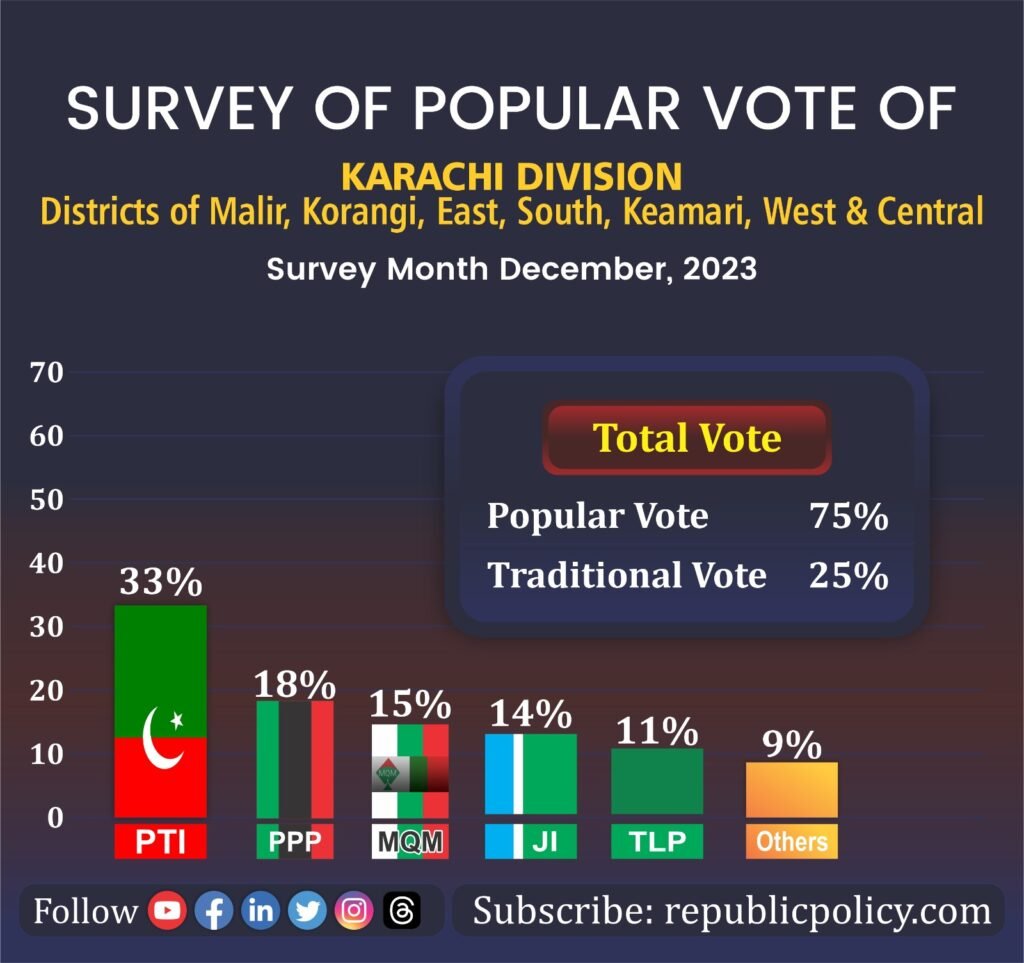
Lastly, constituency politics and popularity in the whole division do not necessarily mean winning the national and provincial seats proportionately.
Critical Evaluation of the Republic Policy Survey:
Karachi, Pakistan’s bustling metropolis, boasts a vibrant and complex political landscape. The city recently underwent revisions, increasing its total National Assembly seats to 22 and Provincial Assembly seats to 47. This report delves into the various factors shaping Karachi’s political terrain, drawing insights from the 2023 local government elections and the December 2023 Republic Policy survey.
Reshuffled Seats and Past Victories:
The seat distribution across districts highlights both stability and change. Malir, East, and Central districts gained an additional Provincial Assembly seat each, while District South saw an increase in National Assembly seats. In the 2018 National Assembly elections, PTI emerged victorious, claiming 14 out of 21 seats.
Local Landscape: A Glimpse into Voting Patterns:
The 2023 local government elections offered a snapshot of Karachi’s diverse political affiliations. PPP emerged as the dominant force, securing 104 Union Council seats. JI followed closely with 89 seats, while PTI remained behind with 42 seats. This outcome suggests a multi-party contest with fluctuating loyalties depending on the political wave and party performance.
Unveiling the Voting Divide:
The Republic Policy survey reveals fascinating insights into Karachi’s voting patterns. Linguistic and ethnic affiliations play a significant role, with Sindhis and Balochs in Malir favouring PPP, while Pathans and Punjabis exhibit a split vote between PPP and PTI. Districts like Keamari and East & South showcase similar trends, with PPP leading among Sindhis and Balochs and MQM garnering support from Urdu-speaking communities. However, the survey identifies a distinct “political wave” phenomenon that transcends these baseline patterns. Since 2013, this wave, often influenced by national issues and party performance, has the potential to swing elections, as witnessed in PTI’s 2018 victory.
District Dynamics: A Closer Look:
Diving deeper into individual districts, we see Malir as a competitive battleground. Despite PPP’s current edge, the district is susceptible to the Karachi wave, potentially benefiting PTI. Keamari paints a different picture, with PPP leading in both NA seats, albeit less influenced by the Karachi wave compared to other districts. In East and South districts, a multi-party race unfolds, with PPP, MQM, PTI, and JI vying for influence among diverse communities.
PTI’s Rise and Challenges:
Meanwhile, PTI suffered setbacks in the local elections. However, the popular wave of the city seems to be with PTI again. The Republic Policy survey presents them as the most popular party, with 33% approval. Their presence across all districts, particularly Central, East, West, and Korangi, and their appeal among Pathans, Urdu-speaking, and Punjabi communities indicate potential success. However, gaining ground among Sindhis and Balochs, who favour PPP in Malir, kemari, and South districts, is a significant challenge.
Beyond Vote Percentages: Understanding the Nuances:
The survey emphasizes the importance of looking beyond mere vote percentages. The 25% “traditional vote bank” across Karachi represents the influence of factions, tribes, and castes in certain areas. While political parties hold greater sway, understanding these traditional networks and their potential swing votes remains crucial for accurate electoral predictions.
Conclusion: A Complex Political Tapestry:
Karachi’s political landscape is a tapestry woven from linguistic, ethnic, and political threads, influenced by the ever-shifting “political wave”. Understanding these complex dynamics is essential for navigating the upcoming 2024 elections. Parties and candidates must recognize the importance of tailoring their strategies to specific communities, addressing both popular concerns and traditional networks, to secure victory in this unpredictable and tightly contested race.
Please, subscribe to the YouTube channel of republicpolicy.com



